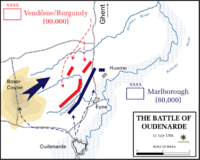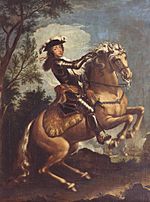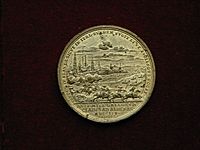Battle of Oudenarde facts for kids
Quick facts for kids Battle of Oudenarde |
|||||||
|---|---|---|---|---|---|---|---|
| Part of the War of the Spanish Succession | |||||||
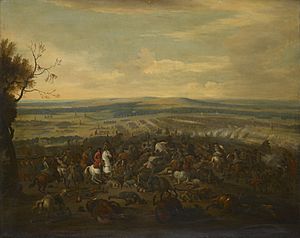 The Battle of Oudenarde, by Jan van Huchtenburg |
|||||||
|
|||||||
| Belligerents | |||||||
| Commanders and leaders | |||||||
| Strength | |||||||
| 90,000 | 80,000-90,000 | ||||||
| Casualties and losses | |||||||
| 3,000 killed or wounded 6,000 killed or wounded |
3,000 killed or wounded, 6,000-7,000 captured 6,000 killed or wounded, 8,000 captured | ||||||
The Battle of Oudenarde was a huge battle during the War of the Spanish Succession. It happened near the city of Oudenaarde on July 11, 1708. This city was in what was then called the Spanish Netherlands.
The battle was fought between the Grand Alliance and France. The Grand Alliance was a group of countries including Britain and the Dutch. They were led by famous generals like the Duke of Marlborough and Prince Eugene. The French army was led by the Duke of Burgundy and the Duke of Vendôme.
The Grand Alliance won a big victory. This win helped them gain control of several French areas. It gave them a major advantage in the war. The war itself was about who would become the next King of Spain. Many countries worried that France and Spain would become too powerful if they were ruled by the same family.
| Top - 0-9 A B C D E F G H I J K L M N O P Q R S T U V W X Y Z |
Why the Battle Happened
The War of the Spanish Succession
The War of the Spanish Succession lasted from 1701 to 1714. It started when King Charles II of Spain died without any children. His closest relatives were from the Austrian Habsburg family and the French Bourbon family.
If one family ruled both Spain and France, it would upset the balance of power in Europe. Other powerful countries worried about this. King Charles II wanted his grandnephew, Philip, to be the next King of Spain. Philip was also the grandson of King Louis XIV of France.
So, in 1701, France and Spain went to war against the Grand Alliance. The Grand Alliance supported a different person, Charles, to be the King of Spain. The main countries in the Grand Alliance were England (later Great Britain), the Holy Roman Empire, and the Dutch Republic. Many people in Spain also joined the side of Charles.
At first, France seemed to be winning because they had a large army and navy. But they suffered big defeats at the Battle of Blenheim and the Battle of Ramillies. After these battles, the war became a stalemate. Neither side could easily move into the other's territory.
French Plans and Allied Moves
In 1708, the French army moved towards the Spanish Netherlands. Their commanders, the Duke of Burgundy and the Duke of Vendôme, argued about what to do next. Vendôme wanted to attack the city of Huy. But King Louis XIV ordered them to attack Flanders instead.
The French army moved east. They reached Braine-l'Alleud, which was south of Brussels. This allowed them to threaten the city of Leuven. The Duke of Marlborough moved his forces to protect both Brussels and Leuven.
For over a month, the French army did nothing. This gave Prince Eugene time to bring his army to join Marlborough. But on July 5, the French suddenly moved west. They quickly captured the cities of Bruges and Ghent. This surprised and worried Marlborough. He waited for Eugene's army to arrive before making any moves.
The French now controlled the Scheldt River from their border all the way to Ghent.
The Race to Oudenaarde
Only one Allied fortress remained in the area: the city of Oudenaarde. If the French captured Oudenaarde, Marlborough's army would be cut off from the coast. This would stop their supplies and communication with England.
Marlborough guessed the French plan. He also figured out how they would try to take Oudenaarde. They would march along the east bank of the Scheldt River, closer to Marlborough's troops. They would also leave a large force between the two armies.
The French army started marching on July 8 towards Lessines. But Marlborough made an amazing forced march. His troops marched very quickly and captured Lessines on July 10. This forced the French commanders to change their plan. They decided to cross the Scheldt River and attack Oudenaarde from there.
Marlborough ordered another forced march. He sent 11,000 troops ahead to hold the main crossing point over the Scheldt. These troops were led by William Cadogan. Cadogan's men built five extra pontoon bridges. These bridges allowed Marlborough to get his 80,000-strong army across the river.
Around 9:00 a.m., French soldiers looking for supplies discovered the Allied troops. This started the battle.
The Battle Begins
William Cadogan, a great cavalry commander, sent his dragoons to capture French soldiers from their advance guard. Many French soldiers escaped and warned their commander, Lieutenant General Charles-Armand de Gontaut, duc de Biron. He was in charge of the French front line.
De Biron was surprised to see so many Allied cavalry already across the river. More Allied infantry were also arriving. Vendôme ordered him to attack. But de Biron hesitated. He saw a strong line of 20 Allied infantry battalions. His own force had only seven infantry battalions and 20 cavalry squadrons. He had also been told that cavalry could not move well in the marshy ground. So, he decided not to cross.
At this time, Prince Eugene and 20 squadrons of Prussian cavalry crossed the river. They took important positions. While de Biron's troops were moving, the leading British infantry arrived. They were led by John Campbell, 2nd Duke of Argyll.
Cadogan, with Marlborough's permission, attacked de Biron's seven battalions of Swiss mercenaries. Cadogan's force was mostly cavalry. The Swiss mercenaries were quickly pushed back. The Allied force destroyed de Biron's units. They had to stop when they met a large group of French cavalry. The future King George II was among the cavalry that pushed back the French.
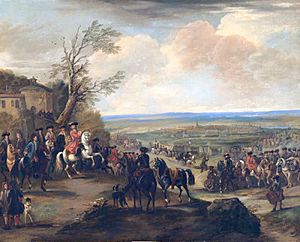
French Mistakes and Allied Pressure
The Duke of Burgundy made another mistake. He decided to attack, even though Vendôme disagreed. The French right side began to attack the Allied positions near Eine. But the French left side stayed still near Huise for some reason.
The Allied left side held a very strong position. Twenty-eight cavalry squadrons protected the right side of Cadogan's infantry. The attack started around 4:00 p.m. Burgundy ordered the attack, which hit Prussian cavalry squadrons. There was intense fighting, but the attack failed.
Then, Vendôme made a questionable decision. He personally led an attack of 12 infantry regiments, fighting with a half-pike. This meant that one French commander (Burgundy) was far away, unable to see the battle. The other commander (Vendôme) was fighting personally and could not direct his troops.
Most historians agree that if the French left side had attacked the weaker Allied right side, the Allies might have had to retreat. Vendôme realized this and asked Burgundy for permission to attack with the left side. But Burgundy's messenger failed to deliver the message. Vendôme thought support was coming for his troops. His troops were spreading out, trying to surround the Allied left side. As French infantry approached, they made the Allied line longer, but too slowly to stop the French from threatening the Allied positions.
Marlborough's Smart Moves
Around this time, two Dutch officials, Sicco van Goslinga and Adolf Hendrik van Rechteren, were near Marlborough. They thought he seemed unsure, perhaps because he had fallen off his horse the night before. They asked Prince Eugene to take overall command. Eugene agreed to help.
Marlborough moved his headquarters to the left side of the battle. Prince Eugene took command of the right side, which was still holding back the French left. Even though the right side was under pressure, Marlborough made a brilliant decision. He brought 18 new infantry battalions from Hesse and Hanover to the left side. He sent 20 battalions from Prussian General Carl von Lottum to support Eugene's men. This brought fresh troops to the important Allied left side. It also strengthened the Allied right side and gave Lottum's troops a much-needed rest.
Marlborough then planned to surround the French army from both sides. He had 25,000 fresh Dutch Army troops under Field Marshal Overkirk. He ordered them to go around the French right side. The Dutch army could not cross the broken pontoon bridges near Oudenaarde. They had to use the stone bridges in the city, which delayed them for an hour.
Marlborough went ahead with his plan. Eugene's cavalry charged towards Burgundy's headquarters. The French Household Cavalry managed to push them back. Marlborough, with only the 18 Hessian and Hanoverian battalions, could only keep the French right side in check.
Around 8:30 p.m., Overkirk's troops arrived and attacked the French right side from the flank. This happened at the same time as a combined attack by Marlborough and Eugene.
The Final Push
Eugene was worried about the left side. He sent the two Dutch officials there with orders to attack the French. Sicco van Goslinga found an exhausted Overkirk. The old general did not see the urgency of an attack.
Van Goslinga then rode to a line of six battalions. He met Lieutenant General Bengt Oxenstierna, who also did not want to attack. He said the ground was too rough. Van Goslinga decided to lead the attack himself. He put himself at the front of two Swiss battalions and ordered them to advance. Five other Dutch battalions followed. The Prince of Orange placed eight more battalions next to Van Goslinga.
The Dutch officials and the young Prince led their troops down the slope. They crashed into the French infantry and quickly pushed them aside. A French counter-attack by their best horsemen did little to change the situation. Sicco van Goslinga wrote: "Our Swiss... were so quiet that I was amazed. ... the hail of musket balls, with which he [the French cavalry] was received, cut down some and routed the rest."
At the same time, the Dutch cavalry cut off the French retreat route to Kortrijk. Much of the French army was defeated or captured. It became dark, so the Allies could not finish surrounding the French. The battle ended in confusion for the Allies. In the darkness, the Allied right and left sides mistook each other for the enemy and started firing. Eugene and the Prince of Orange stopped the firing and prevented their own army from hurting itself.
After the Battle
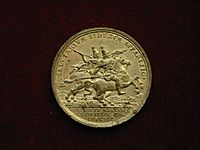
The French army retreated in a mess towards Ghent. The Duke of Burgundy and the Duke of Vendôme argued about who was to blame for the defeat. Only the darkness and some broken bridges saved the French army from being completely destroyed.
For some reason, about half of the French forces were kept in reserve and never joined the battle. A large group of French cavalry and infantry stayed on high ground north of the Norken River. Many of Burgundy's troops also stayed inactive. They did not help their fellow French soldiers, even when the battle turned against them. Many French cavalry squadrons stayed in reserve because they were told the ground was too difficult for their horses.
The French commanders made several big mistakes:
- The entire French left side was kept in reserve. They could have easily destroyed the weaker Allied right side.
- If they had attacked together, with Vendôme attacking the Allied right flank and Burgundy attacking with the left side, the French could have won.
- The Duke of Burgundy's decision to fight personally meant he could not command his troops. This was disastrous when the Allies surrounded the French.
The French army lost about 14,000 to 15,000 soldiers. About 8,000 of them were taken prisoner. They also lost 25 artillery guns. The Allies lost about 3,000 men. Some sources say the Allies lost 6,000 men.
On the other hand, the Allied commanders became even more famous. Marlborough showed his skill in choosing the right ground, timing his moves, and knowing his enemy. Eugene's reputation also grew. While Marlborough was in overall command, Eugene led the important right flank and center. The two commanders worked together very well. Marlborough wrote, "Prince Eugene and I shall never differ about our share of the laurels."
This victory gave the Allies the advantage again. They decided to besiege Lille, which was the strongest fortress in Europe. Eugene led the siege, and the city surrendered on October 22. The strong commander of the citadel, Boufflers, finally gave up on December 10. Even with the difficulties of a winter siege, the campaign of 1708 was a great success. It showed excellent planning and organization. The Allies took back Bruges and Ghent. The French were driven out of almost all the Spanish Netherlands. Eugene wrote, "He who has not seen this has seen nothing."
See also


